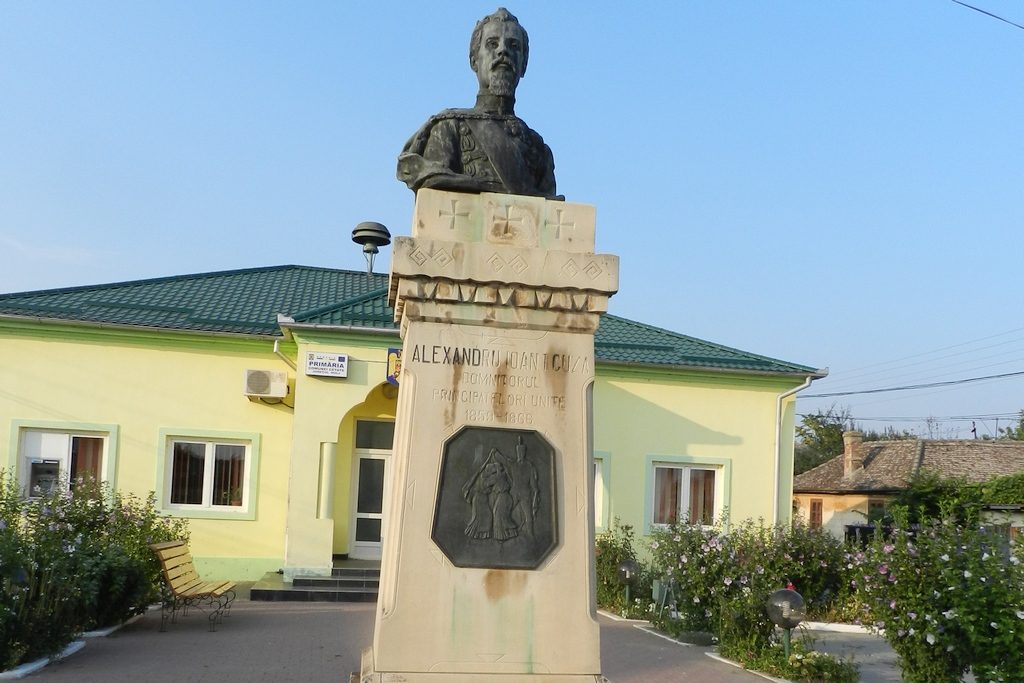

The bust was built up in the memory of Alexandru Ioan Cuza. Born in Bârlad, Cuza belonged to the traditional class of aristocrats from Moldavia, being the son of the sub-prefect Ioan Cuza and of the Sultan, member of the family Cozadini of Phanariot origin. Alexandru received an European education, becoming an officer in the Moldavian army and reaching the degree of colonel. He got married with Elena Rosetti in 1844.
In the year 1848, Moldavia and Wallachia were also under the fever of the European revolutions. The revolt of the Moldavians was suppressed quickly, but in Wallachia the revolutionaries took over the command and governed during the summer. The young Cuza played quite an important role in order to accentuate his liberal inclinations, which he had during the Moldavian episode, therefore he is transported as a prisoner at Vienne, from where he was freed with the British help.
Coming back in Moldavia during the reign of Prince Grigore Alexandru Ghica, he became a war minister of Moldavia, in 1858, and he represented Galați in the ad-hoc divan from Iași. Cuza was an outstanding politician and strongly supported the union of Moldavia and Wallachia. He was nominated in both the countries by the National Party, which militated for the union, in the one against a foreign prince. Taking advantage of the ambiguity in the text of the Treaty from Paris, he is chosen as Prince of Moldavia on the 17th of January 1859 (the 5th of January after the Julian calendar) and in Wallachia on the 5th of February 1859 (the 24th of January according to the Julian calendar).
The Union of the Romanian Principalities took place at the middle of the XIXth century and represents the unification of the old state of Moldavia and of Wallachia. The union is strongly connected to the personality of Alexandru Ioan Cuza and of his chosing as a prince of both the principalities. The favorable popular vote of the union in both the countries, result following the ad-hoc meetings from 1857 led to the Convention from Paris from 1858, an agreement between the Great Powers through whom it was accepted a more formal union between the two countries, with different governments and with some common institutions. At the beginning of the next years, the union Moldavian leader Alexandru Ioan Cuza was chosen as prince of Moldavia and of Wallachia, bringing them into a personal union. In 1862, with the help of the unionists from the two countries, Cuza unified the Parliament and the Government, executing the political union. After his dismiss from the power in 1866, the union was consolidated by bringing to the throne the prince Carol of Hohenzollern – Sigmaringen, and the constitution adopted in the same year named the new state Romania.
After the Convention from Paris from 1858, the great powers left the government of each Romanian principality in the command of the new provisional commission, formed by three kaymakams, until the choosing of the princes. The moldavian unionists were able to easily impose the candidacy at the throne of the colonel Alexandru Ioan Cuza, who was chosen as prince with a unanimity of votes on the 5th/17th of January 1859.
After performing the union, the prince Alexandru Ioan Cuza and his closest collaborator, Mihail Kogălniceanu, (minister, then prime-minister of Romania), initiates important internal reforms: the secularization of the monastery fortunes (1863), the agrarian reform (1864), the reform of education (1864), the reform of justice (1864) and others, which fixed a modern frame for developing the country.
